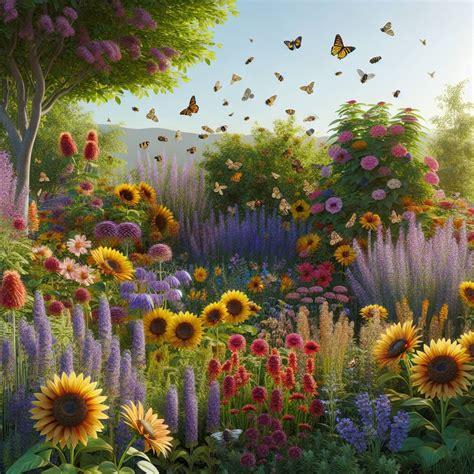Top Flowering Plants for Pollinator-Friendly Balcony Gardening
Urban living comes with its limitations, especially when it comes to gardening. But even in small balcony spaces, you can create an inviting haven for pollinators like bees, butterflies, and hummingbirds by choosing the right flowering plants. Not only does balcony gardening enhance outdoor beauty, but it also promotes biodiversity and contributes to pollinator support, helping you create a thriving ecosystem within the constraints of city life. Let’s dive into the best plant choices and gardening tips to attract pollinators to your balcony.
Key Concepts in Balcony Gardening for Pollinators
- Pollinators: Bees, butterflies, and other species that assist in plant reproduction by transferring pollen.
- Container Gardening: Growing plants in containers, which is ideal for limited spaces like balconies.
- Flowering Plants: Plants that produce blooms to attract pollinators for reproduction.
- Urban Gardening: Growing plants in city environments where space is limited, often utilizing balconies and rooftops.
Historical Context of Pollinator Gardening
The idea of cultivating plants specifically for pollinators dates back centuries. Historically, rural gardens naturally supported local biodiversity, but urbanization has greatly reduced the availability of flowering plants. Over time, urban gardening has become an important effort to recreate lost green spaces. In recent decades, city dwellers have increasingly adopted container gardening techniques, enabling them to contribute to pollinator conservation even from the confines of a small balcony.
Current State of Balcony Gardening for Pollinators
Today, balcony gardening is no longer just a hobby; it’s a solution for fostering urban biodiversity. With the correct selection of flowering plants, urban gardeners can create effective pollinator habitats. Research shows that pollinators like bees and butterflies can thrive in city settings, provided they have access to nectar and pollen sources. Balcony gardens now play a vital role in supporting these species.
Practical Applications: Best Flowering Plants for Pollinator Attraction
| Flowering Plant | Pollinators Attracted | Growing Tips |
|---|---|---|
| Lavender | Bees, Butterflies | Prefers full sun; drought-tolerant; fragrant blooms |
| Marigolds | Bees, Butterflies | Easy to grow; bright colors attract pollinators; sun-loving |
| Salvia | Hummingbirds, Bees | Grows well in containers; prefers partial to full sun |
| Echinacea (Coneflower) | Bees, Butterflies | Thrives in full sun; low maintenance; long-lasting blooms |
| Fuchsias | Hummingbirds | Shade-tolerant; ideal for hanging containers; vibrant colors |
| Sunflowers | Bees, Butterflies | Needs direct sunlight; grow in deep containers for tall varieties |
| Zinnias | Butterflies, Bees | Plant in full sun; tolerant to heat; variety of colors |
| Bee Balm | Bees, Hummingbirds | Full sun to partial shade; attracts pollinators with minty scent |
| Geraniums | Bees, Butterflies | Adaptable to various light conditions; blooms attractively in summer |
| Snapdragons | Bees | Requires moderate watering; grows well in containers |
Case Studies: Successful Balcony Gardens for Pollinators
Case Study 1: Small Space, Big Impact — A 6th-floor balcony garden in Brooklyn, New York, featured a combination of lavender, sunflowers, and fuchsias. Despite limited space, the vibrant flowers attracted honeybees, bumblebees, and hummingbirds, making it a thriving pollinator hotspot in the middle of a busy city.
Case Study 2: Butterfly Haven — In Berlin, a small urban balcony was transformed into a butterfly-friendly space using zinnias and echinacea. The owner observed an influx of monarch butterflies within weeks of planting.
Stakeholder Analysis: Who Benefits?
- Urban Gardeners: They get to enjoy beautiful plants and the satisfaction of supporting pollinators.
- Pollinators: They gain critical nectar and pollen sources that are otherwise scarce in urban environments.
- Local Communities: Increased biodiversity and more green spaces benefit everyone, creating healthier environments.
- Environmentalists: Pollinator support aligns with wider conservation goals.
Implementation Guidelines for Pollinator-Friendly Balcony Gardens
- Choose the Right Plants: Opt for native flowering plants that produce nectar and pollen.
- Use Varied Containers: Maximize space by using hanging baskets, railing planters, and window boxes.
- Ensure Sun Exposure: Most pollinator-attracting plants thrive in full sunlight, so place containers accordingly.
- Provide Water Sources: Pollinators need water; small shallow dishes with pebbles make excellent watering stations.
- Maintain Consistent Blooms: Plant a variety of species to ensure continuous flowering throughout the seasons.
- Avoid Pesticides: Use organic solutions to protect both your plants and the pollinators.
Ethical Considerations of Balcony Pollinator Support
Creating balcony spaces for pollinators raises questions about ecological ethics. On the one hand, these efforts help alleviate the global decline of pollinator species. However, there are concerns that urban gardening could introduce invasive species or unintentionally harm local ecosystems. For instance, some non-native plant species might displace local flora, negatively impacting pollinator populations. To mitigate this, it’s essential to choose plants that are native or at least non-invasive, ensuring harmony within the local environment.
Limitations and Future Research Directions
While balcony gardens offer significant benefits to urban biodiversity, there are limitations. First, the size of balconies restricts the number of plants that can be grown, limiting the overall impact on pollinator populations. Second, pollution in urban areas may affect the health of pollinators visiting these spaces. Future research could explore ways to optimize small spaces for greater pollinator support and investigate the long-term effects of urban pollutants on pollinator health.
Expert Commentary on Balcony Gardening and Pollinator Support
Experts agree that balcony gardens, despite their small scale, can play a crucial role in urban ecosystems. Dr. Jane Morris, a leading horticulturist, notes that even a few well-chosen flowering plants can create microhabitats that support diverse pollinator species. “It’s not just about what you plant,” she says. “It’s about providing the right conditions—sunlight, water, and continuous blooms—to ensure pollinators thrive.”
Furthermore, Dr. Robert Klein, an urban ecologist, highlights the importance of understanding local environmental dynamics. “Balcony gardeners must be mindful of their plant choices,” he states. “Native species are often the best option because they support local wildlife without disrupting the ecosystem.”
As urban gardening continues to grow in popularity, so too does its potential for innovation. Experts are now exploring green technologies, such as vertical gardens and pollinator-friendly rooftops, which could enhance the impact of urban gardening on biodiversity.


